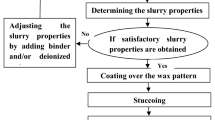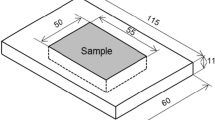Abstract
Investment casting is a highly flexible process which was previously perceived as an expensive process. However, when the process is compared to other optional processes which may require machining or welding, this casting can produce metallic components at highly competitive costs. There are many process variables which affect the process such as die temperature, wax temperature, injection pressure, shell firing temperature and time, cooling rate. In this study, important shell parameters such as preheat temperature, firing temperature and firing time, and melt pouring temperature have been chosen as process variables influencing the quality of the hypoeutectic aluminium–silicon alloy investment casting. The optimal input parametric condition for reduction of linear and volumetric shrinkages and increment of tensile strength of Al–Si 7%–Mg investment casting has been identified as shell preheat temperature of 200 °C, firing temperature of 900 °C, firing time of 7 h and pouring temperature of 600 °C. At this optimal setting, it was found that linear and volumetric shrinkages decreased from 0.65 and 1.89% to 0.381 and 1.546%. The tensile strength of the casting increased from 96 to 121 MPa with regard to the nine experimental runs performed. Microstructural observation revealed that higher shell preheat and pouring temperatures led to augmented porosity, increased secondary dendrite arm spacing (35.53 ± 2.4 μm), larger detrimental iron-rich intermetallics (40.49 ± 25.15 μm) followed by reduced tensile properties of the casting (96 MPa).






Similar content being viewed by others
References
Casting (1998) ASM international, ASM metals handbook, vol 15. The Materials Information Company
Calcom SA (2001) Simulating porosity in ductile iron castings. Parc Scientifique EPFL, CH-1015 Lausanne, Switzerland
Pattnaik SR, Karunakar DB, Jha PK (2012) Developments in investment casting process—a review. J Mater Process Technol 212:2332–2348
Pattnaik SR, Karunakar DB, Jha PK (2013) Multi-characteristic optimization of wax patterns in the investment casting process using grey–fuzzy logic. Int J Adv Manuf Technol 67:1577–1587
Dong YW, Li XL, Zhao Q, Yang J, Dao M (2017) Modeling of shrinkage during investment casting of thin-walled hollow turbine blades. J Mater Process Technol 244:190–203
Bonilla W, Masood SH, Iovenitti P (2001) An investigation of wax patterns for accuracy improvement in investment cast parts. Int J Adv Manuf Technol 18:348–356
Rezavand SAM, Behravesh AH (2007) An experimental investigation on dimensional stability of injected wax patterns of gas turbine blades. J Mater Process Technol 182:580–587
Yarlagadda PKDV, Hock TS (2003) Statistical analysis on accuracy of wax patterns used in investment casting process. J Mater Process Technol 138:75–81
Pattnaik SR, Karunakar DB, Jha PK (2013) Influence of injection process parameters on dimensional stability of wax patterns made by the lost wax. Proc Inst Mech Eng L J Mater Des Appl 227(1):52–60
Pattnaik SR, Karunakar DB, Jha PK (2013) Parametric optimization of the investment casting process using utility concept and Taguchi method. Proc Inst Mech Eng L J Mater Des Appl. https://doi.org/10.1177/1464420713487654
Pattnaik SR, Karunakar DB, Jha PK (2013) Modeling and parametric optimization of investment casting process by uniting desirability function approach and fuzzy logic. J Intell Fuzzy Syst. https://doi.org/10.3233/IFS-130809
Cheng X, Yuan C, Shevchenko D, Withey P (2014) The influence of mould pre-heat temperature and casting size on the interaction between a Ti–46Al–8Nb–1B alloy and the mould comprising an Al2O3 face coat. Mater Chem Phys 146:295–302
Yuan C, Cheng X, Holt GS, Shevchenko D, Withey P (2014) Investment casting of Ti–46Al–8Nb–1B alloy using moulds with CaO-stabilized zirconia facecoat at various mould pre-heat temperatures. Ceram Int. https://doi.org/10.1016/j.ceramint.2014.11.109
Casting Design and Performance (2009) ASM international. The Materials Information Society, Page, p 62
Das S, Mondal DP, Sawla S, Ramkrishnan N (2008) Synergic effect of reinforcement and heat treatment on the two body abrasive wear of an Al–Si alloy under varying loads and abrasive sizes. Wear 264:47–59
Flemings MC (1974) Solidification processing. McGraw-Hill Inc., London
Arulraj M, Palani PK (2018) Parametric optimization for improving impact strength of squeeze cast of hybrid metal matrix (LM24–SiCp–coconut shell ash) composite. J Braz Soc Mech Sci Eng. https://doi.org/10.1007/s40430-017-0925-3
Mishra S, Ranjana R (2010) Reverse solidification path methodology for dewaxing ceramic shells in investment casting process. Mater Manuf Process 25:1385–1388
Tian GL, Bu K, Zhao DQ, Zhang YL, Qiu F, Zhang XD, Ren SJ (2018) A shrinkage prediction method of investment casting based on geometric parameters. Int J Adv Manuf Technol 96:1035–1044. https://doi.org/10.1007/s00170-018-1618-5
Venkat Y, Singh S, Das DK, Pandey AK (2018) Effect of fine alumina in improving refractoriness of ceramic shell moulds used for aeronautical grade Ni-base superalloy castings. Ceram Int. https://doi.org/10.1016/j.ceramint.2018.03.197
Brown RA, Brown CA (1970). Investment shell molds for the high integrity precision casting of reactive and refractory metals, and methods. Patented No. 3,537,949
Li YM, Li RD (2001) Effect of casting process variables on microporosity and mechanical properties in an investment cast aluminium alloy. Sci Technol Adv Mater 2:277–280
Sidhu BS, Kumar P, Mishra BK (2008) Effect of slurry composition on plate weight in ceramic shell investment casting. JMEPEG 17:489–498. https://doi.org/10.1007/s11665-007-9162-8
Beeley PR, Smart RF (1995) Investment casting, 1st edn. The Institute of Materials, London
Birol Y (2009) Semi-solid processing of the primary aluminium die casting alloy A365. J Alloys Compd 473:133–138
Yang LJ (2003) The effect of casting temperature on the properties of squeeze cast aluminium and zinc alloys. J Mater Process Technol 140:391–396
Campbell J (1991) Castings. Butterworths-Heinemann, Oxford, pp 261–268
Lim CS, Clegg AJ, Loh NL (1997) The reduction of dendrite ARM spacing using a novel pressure-assisted investment casting approach. J Mater Process Technol 70:99–102
Author information
Authors and Affiliations
Corresponding author
Additional information
Technical Editor: Márcio Bacci da Silva.
Rights and permissions
About this article
Cite this article
Pattnaik, S. Investigation on controlling the process parameters for improving the quality of investment cast parts. J Braz. Soc. Mech. Sci. Eng. 40, 318 (2018). https://doi.org/10.1007/s40430-018-1246-x
Received:
Accepted:
Published:
DOI: https://doi.org/10.1007/s40430-018-1246-x




